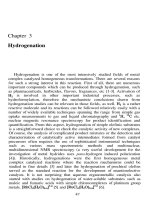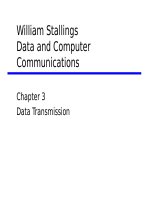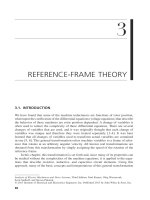Chapter 3: COMMON REACTION MECHANISMS potx
Bạn đang xem bản rút gọn của tài liệu. Xem và tải ngay bản đầy đủ của tài liệu tại đây (900.15 KB, 62 trang )
1
ORGANIC CHEMISTRY
Dr Nam T. S. Phan
Faculty of Chemical Engineering
HCMC University of Technology
Office: room 211, B2 Building
Phone: 8647256 ext. 5681
Email:
2
Chapter 3: COMMON REACTION
MECHANISMS
Elimination
Electrophilic substitution
Nucleophilic substitution
Nucleophilic addition
Electrophilic addition
Reaction mechanism: the description of the
step-by-step process by which reactants
are changed / converted into products
3
NUCLEOPHILIC SUBSTITUTION
REACTIONS (S
N
)
•
A nucleophile: an electron-rich species that can
form a covalent bond by donating 2 electrons to a
positive center
•
A nucleophile is any negative / neutral molecule
that has 1 unshared electron pair
•
Substitution reaction: chemical reaction in which
1 atom / group replaces another atom / group in the
structure of a molecule
•
In a nucleophilic substitution reaction, a
nucleophile attacks / bonds with the positive center
4
5
BIMOLECULAR NUCLEOPHILIC
SUBSTITUTION REACTION (S
N
2)
6
7
Stereochemistry of S
N
2 reactions
•
The nucleophile attacks from the back side / the side
directly opposite the leaving group
•
This attacks causes an inversion of configuration
8
9
UNIMOLECULAR NUCLEOPHILIC
SUBSTITUTION REACTION (S
N
1)
10
Note: slow step is rate-determining step
11
12
Stereochemistry of S
N
1 reactions
13
However, few S
N
1 reactions occur with
complete racemization
14
Factors affecting the rates of
S
N
1 & S
N
2
1. The structure of the substrate
2. The concentration & reactivity of
the nucleophile
3. The reaction solvent
4. The nature of the leaving group
15
Affects of substrate structure
Steric effect in the S
N
2 reaction
Steric
hindrance
16









